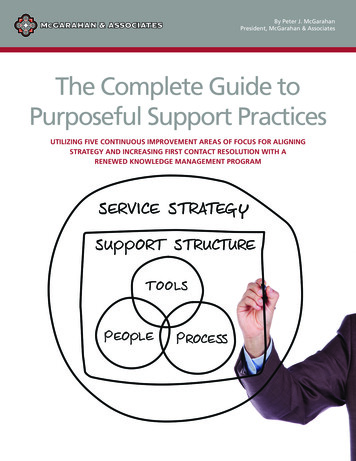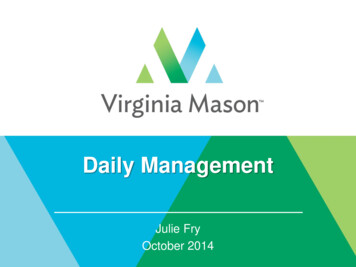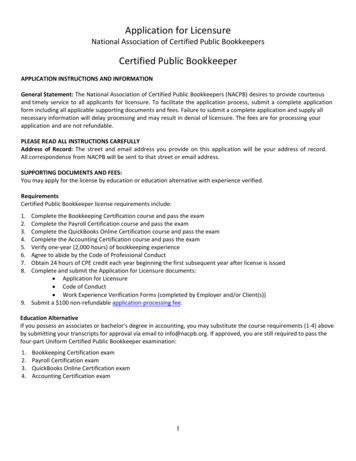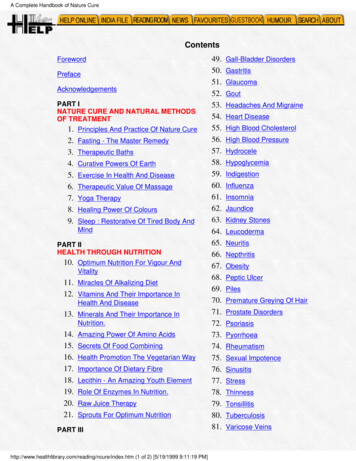
Transcription
By Peter J. McGarahanPresident, McGarahan & AssociatesThe Complete Guide toPurposeful Support PracticesUTILIZING FIVE CONTINUOUS IMPROVEMENT AREAS OF FOCUS FOR ALIGNINGSTRATEGY AND INCREASING FIRST CONTACT RESOLUTION WITH ARENEWED KNOWLEDGE MANAGEMENT PROGRAM
Table of ContentsThis guide outlines the path to an aligned service strategy, structure to support and governpeople, integrated processes and tools supported by a balanced performance scorecard.Introduction: Purposeful Support Practices . 3Service Strategy . 6Purposeful Practices. 81. Achieving First Contact Resolution. 82. Making UFFA a Priority . 103. Mapping Call Types for Action . 114. Introducing New Technologies . 125. Balanced Scorecard Storytelling . 15The Art of What’s Possible . 16Bang for the Buck: Generating a Continuous Return . 19 McGarahan & Associates. All rights reserved. www.mcgarahan.com2
Introduction: Purposeful Support PracticesToday’s demanding business and service environment is unforgiving, especially for those whoservice customers, technology and the organization. Customers expect that companies who wanttheir reoccurring business will consistently meet and exceed their expectations. The employee orcustomer who relies on technology as a productivity tool trusts that the Support Center issufficiently well-equipped and knowledgeable to quickly understand the issue and resolve it.The only thing that matters is that the Support Center quickly returns them to productivity —with little to no pain! Exceeding customer’s expectations time and time again only happens whenservice and support leaders have an aligned service strategy, a strong structure and purposefulsupport practices.Service leaders who define strategy, prioritize tactics and manage operations will be challengedover the next five years to improve the Support Center’s performance while integrating businessand technology initiatives. These include cloud computing (providing IT services, not infrastructure), mobile computing, global workforce support and team virtualization (smaller, greenerfootprint). Designed according to the realities of the reactive day-to-day support operations, thepurposeful support practices have a more practical, common-sense approach to implementingsupport processes.STRATEGICTACTICALOPERATIONALCreating long-termvision, goals andobjectives based onachieving a desiredend resultImplementingprojects or continuousimprovement activitiesmoving you closer toachieving your strategicgoals / objectivesRepetitive activitiesthat are the day-to-daycore processes thatachieve the tacticalperformance goals,objectives & SLAs“It’s tough to be strategic when you are deliveringdaily operations tactically.”Service leaders must allocate the right amount of time for strategic thinkingand initiatives to (1) align goals and objectives, (2) establish directives to governscope of services and (3) build success metrics to measure business value.As service leaders examine and assess their operations, they must automate and integrate the supporttechnology into the process workflow, empowering and enabling the frontline service representatives. McGarahan & Associates. All rights reserved. www.mcgarahan.com3
In the pursuit of operational excellence, be mindful to always:1. Know where you are — Assessing your current performance around service strategy,structure (support model), process, people, tools and metrics is an all-important baseline. Track progress against the continuous improvement roadmap.2. Know where you are going — Envisioning the end result is a core part of defining yourservice strategy. Determine the right outcome for the customer and the business.3. Know how you plan to get there — The continuous improvement roadmap is theresult of your gap-analysis assessment against your future-state. Decide how you will get from where you are to where you want to be – using establishedtargets of success metrics positioned along the journey.This guide highlights how the integration of the Citrix Online GoToAssist and GoToManage solutions with the purposeful support practices helps businesses increase revenue (customersatisfaction, loyalty and retention) while reducing support cost (quicker problem resolution).The Five Purposeful Practices are:1.2.3.4.5.Achieving First Contact ResolutionMaking UFFA a PriorityMapping Call Types for ActionIntroducing Customer-Impacting TechnologiesBalanced Scorecard StorytellingLeading technology solution providers like Citrix Online are committed to improving thecustomer experience by quickly delivering a return on the tool investment and strengtheningthe team’s performance. By keeping focused on purposeful support practices, the Support Centeris in the best position to utilize technology and process to: Resolve difficult problems faster Increase first contact resolution Deliver a more consistent and memorable customer experience. McGarahan & Associates. All rights reserved. www.mcgarahan.com4
Proactively Manage the DemandNormally, customer demand for support is simple to meet. The Support Center providescustomers with access channel choices (e.g., phone, chat, email, self-service portal, etc.), and thecustomers then select the appropriate contact method that best suits their preference, theirsituation and the urgency of their issue. However, large groups of customers may occasionallycontact the Support Center at the same time when a service disruption or outage occurs. Theseincidents significantly impact the ability of the Support Center to consistently meet establishedservice level commitments. How well you prepare and manage any crisis will reflect on yourleadership, as well as the capability and maturity of your Support Center.Customers expect to be able to choose how they request service. Here are some key considerationsthat should be made before allowing customers to access the Support Center throughmultiple channels.Click on “Call VolumeSpikes” to Access Our WhitePaper For Proactive Tipson Successfully ManagedCall Volume Spikes. Discontinue supporting customers through different “band-aid” incident, requestand resolution management processes that use old software, non-integratedtools and heavy customization — all of which limits additional functionalityand capability! Provide the same customer experience across all access “touch-point” channels. Automate and integrate all processes / technologies into one tightly unified,efficient way to deliver service and support.No matter what channel customers access, it’s important that they are positioned to receive rapidresponse and rapid resolution. Knowing when and how to utilize the tool is critical for “speed toresolution.” This consistent handling process also needs to be secure, seamless and effective.For example, when integrating chat and remotesupport, representatives should be prepared to easilyhandle specific, just-in-time training opportunities. Apurposeful support practice would be to resolve moreissues at first contact (FCR). When a customer’s issueor question is not resolved on first contact, the rippleeffect becomes time-consuming and expensive. If FCRis not possible, the representative should request apreferred time and contact method before letting thecustomer go. This simple action eliminates a costlyexchange of emails and phone calls trying to reconnectwith the customer to resume the resolution process. McGarahan & Associates. All rights reserved. www.mcgarahan.comAll CustomersAll Access ChannelsOne consolidated,streamlined, efficient,cost-effective and integratedprocess / tool / people5
Service Strategy“Strategy without tactics is the slowest route to victory.Tactics without strategy is the noise before defeat.”Sun Tzu (Chinese General and Author, b.500 BC)In my many consulting engagements and conversations with senior support managers, I’ve foundthat the leaders are separated from the followers by the creation of a Service Strategy. Serviceleaders must allocate the right amount of time for strategic thinking and initiatives to (1) aligngoals and objectives, (2) establish directives to governscope of services and (3) build success metrics to measurebusiness value. The service strategy is the “place mat” at theexecutive table. A flexible and adaptive strategy and supportstructure can allow you to respond quickly to changing customer preferences, market conditions and competitive threats.I recommend continued investments in technology, resourcesand leadership that enhance the customer experience, reduceoperational costs and create opportunities for scaling the business without the additional expense.The “shift-left” service strategy is to simply identify whereissues are resolved in the tiered support model (who resolveswhat) and target repetitive and reoccurring issues for resolutioncloser to the customer (e.g., First Contact or Self-Service). Theultimate success is achieved by eliminating issues / calls throughProblem Management and Root Cause Analysis (RCA):1. Examine all issues, questions and requests and where they are ultimately resolved —shift resolution to the most-efficient and cost-effective resources.2. Track percentage of resolved cases by resource, team, and location along with cost, utilizationand effectiveness metrics.3. Calculate cost per call / contact / resolution along with plans to shift resolutions closest to thecustomer and lower costs.The “shift-left” strategy also benefits by separating incidents from Service Requests (SR). Thispositions the Support Center to redirect Service Requests (SR) to the self-service portal wherecompleted online forms are automatically routed to the assigned group for fulfillment. Whereasincidents, governed by the Service Level Agreement Priority Model, are reported by customersvia their preferred channel to be routed, responded and resolved in accordance with its priorityassignment. McGarahan & Associates. All rights reserved. www.mcgarahan.com6
The objective of the IT Infrastructure Library-based Incident Management process is to minimizethe productivity impact to the customer and employee by resorting them as soon as possible.Reactively, it works. Proactively, we need to incorporate a more strategic, focused approach thatincludes call deflection (self-service) and call elimination (root cause as analysis).This white paper highlights the Purposeful Support Practices involving the integration oftools, people and process with a discipline around measuring and reporting.Contractual AgreementsSLAOLAUCLevel 2 SpecialistWeb/DB ImagingLevel 2 SpecialistIS OPS ServicesNew CustomersLevel 2 SpecialistNetwork & TechnicalServicesCustomerSupportCenterExiting CustomersLevel 3Vendor SupportApplicationsLevel 2 SpecialistQA/SecurityLevel 3Vendor SupportProgramsLevel 2 SpecialistBusiness 800-HELPLINELevel 3Vendor SupportInfrastructureLevel 2 SpecialistCRM/ArchitectureEmployeesLevel 2 SpecialistBusiness SystemServicesLevel 2 SpecialistBusiness Analysis &Process ServicesPartnersGuaranteeing Seamless Transparency and Service DeliveryQuestions, Issues, Tasksand RequestsProvideKnowledge / TrainingCommit toResponse / Resolution TimeHold Vendor Accountableto Underpinning Contract“Shift L ft” St“Shift-Left”Strategyt gyCall Elimination /Self-ServiceIncrease First ContactResolution (FCR)Reduce EscalationsBusiness / TechnicalReduce / EliminateDispatchSLA Service Level AgreementOLA Operating Level AgreementUC Underpinning Contract McGarahan & Associates. All rights reserved. www.mcgarahan.com7
Purposeful PracticesBest and Good Practices in the support industry are plentiful. They are made available to practitioners and service leaders though industry standards and frameworks such as IT InfrastructureLibrary v3 (ITIL v3), the Capability Maturity Model (CMM), Control Objectives for Information and Related Technology (COBIT), HDI Certification Standards and Courses, NextPractices in Business Service Management and the many Best Practice LinkedIn Groups. Thesemostly process practices are guidelines for focusing more on “what you should be doing” ratherthan “how you should be doing it” with little to no regard for the environmental factors.In a recent Cutter Consortium article entitled “IT's Change Imperative: No IT ProfessionalLeft Behind,” I reference game-changing technologies and their impact on traditional IT careers,positions and skill sets. This wake-up call is best described by a quote from four-star US General(Ret.) Eric Shineski: “If you don't like change, you'll like irrelevance even less.” This statement compelled me to alert service leaders of what they needed to do to take action. They needto prepare and train their service representatives on the state-of-the-art technology today.They also need to begin automating and integrating best practice process into the workflow oftechnology solutions like GoToManage.Purposeful Practices are an innovative way to look at these widely accepted processes withan emphasis on achieving a desired, measurable end result. Purposeful Practices are alwaysopen to investigation and continuous improvement to increase the value of these services tothe business.The Purposeful Practices are:Practice: 1. Achieving First Contact ResolutionDEFINITION: First Contact Resolution is achieved when theservice representative taking the initial report(as delivered through phone, email, chat or selfservice request) is th
3. Calculate cost per call / contact / resolution along with plans to shift resolutions closest to the customer and lower costs. The “shift-left” strategy also benefits by separating incidents from Service Requests (SR). This positions the Support Center to redirect Service Requests (SR) to the self-service portal where










